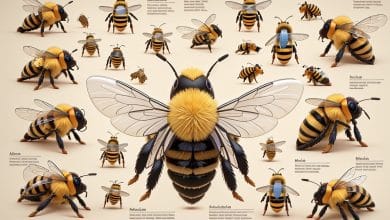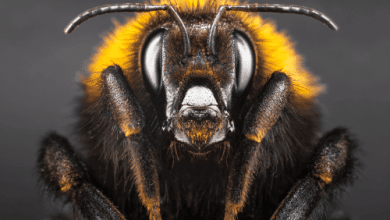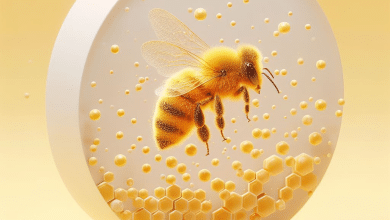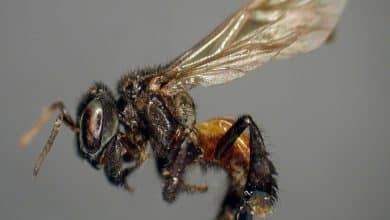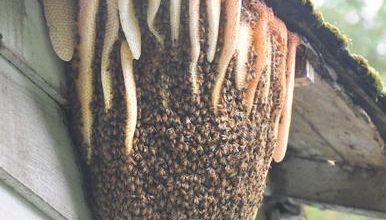characteristics of honey bee

The honey bee, scientifically known as Apis mellifera, is a fascinating and essential insect species that plays a crucial role in our ecosystem. These bees are well-known for their ability to produce honey, which has been treasured by humans for centuries for its sweetness and various health benefits. However, honey bees are not just honey producers; they are also remarkable creatures with unique physical, behavioral, and reproductive characteristics.
Honey bees are social insects that live together in large colonies. Each colony consists of three types of bees: the queen, drones, and worker bees. The queen is responsible for reproduction, while drones have the primary purpose of mating with the queen. Worker bees, which make up the majority of the colony, take care of various tasks such as foraging for food, building and maintaining the hive, and raising the brood.
These bees have distinct physical characteristics that set them apart from other insects. They have a hairy body, six legs, and two pairs of wings. The coloration of honey bees can vary, with most individuals displaying a yellow and black pattern. However, some honey bees can also be brown or even completely black.
In addition to their physical traits, honey bees exhibit complex and fascinating behavior patterns. They communicate through intricate dances, allowing them to convey information about the location of food sources to other members of the colony. Honey bees are also known for their extraordinary navigation abilities, as they can navigate long distances and find their way back to the hive with precision.
Overall, honey bees are not only valuable for their production of honey and other bee products but also for their crucial role in pollination. These diligent pollinators play a vital role in maintaining the biodiversity of plants and ensuring the production of various fruits and vegetables that are important for human consumption.
In the face of numerous threats such as habitat loss, pesticide use, and climate change, conservation efforts are essential to protect honey bee populations. By implementing measures to preserve their habitats, minimize pesticide exposure, and educate the public about their importance, we can work towards safeguarding these remarkable creatures for future generations.
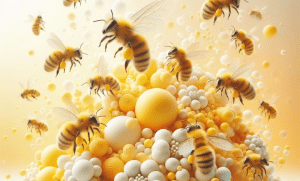
Physical Characteristics of Honey Bees
Honey bee possess distinct physical characteristics that differentiate them from other insect species. Their bodies are covered in fine, dense hairs, which serve multiple purposes. These hairs help the bees collect and carry pollen as they forage for food, and they also provide insulation and protection against extreme temperatures. The hairs also aid in the distribution of pheromones, which play a vital role in communication within the colony.
In terms of size, honey bees are relatively small insects. The average adult worker bee measures around 15 mm (0.6 inches) in length, while the queen bee is slightly larger, typically measuring around 20 mm (0.8 inches). Drones, on the other hand, are the largest bees within the colony, with an average length of 17 mm (0.7 inches).
Color variations can be observed among honey bees, although the majority exhibit the recognizable pattern of alternating yellow and black stripes. This color scheme serves as a warning mechanism to potential predators, indicating that their bodies contain toxins that can cause discomfort or even injury.
It is worth noting that not all honey bees conform to the classic yellow and black pattern. Some individuals may have a darker brown coloration, while others may appear almost entirely black. These variations in color may be influenced by genetic factors or environmental factors, such as temperature and available food sources.
Overall, the physical characteristics of honey bees, including their hairy bodies, small size, and distinct color patterns, contribute to their ability to function effectively within the colony and to fulfill their essential roles in pollination and honey production.
Physical Appearance of Honey Bees
Honey bee have distinct physical characteristics that set them apart from other insects. They have a compact body covered in fine, dense hairs, which serve various purposes. These hairs enable honey bees to collect and transport pollen as they forage for food. Additionally, they provide insulation and protection against extreme temperatures. The hairs also help in the distribution of pheromones, essential for communication within the colony.
In terms of size, honey bees are relatively small insects. Worker bees, which are the most common bees in the colony, measure around 15 mm (0.6 inches) in length. The queen bee, who is responsible for reproduction, is slightly larger, typically measuring around 20 mm (0.8 inches). Drones, the male bees, are the largest within the colony, with an average length of 17 mm (0.7 inches).
The iconic black and yellow stripes are the most recognizable color pattern of honey bees. This serves as a warning mechanism to potential predators, indicating that their bodies contain toxins that can cause discomfort or injury. However, honey bees can also display variations in coloration. Some individuals may have a darker brown color, while others may appear almost entirely black. These variations can be influenced by genetic factors or environmental conditions, such as temperature and available food sources.
Overall, the physical characteristics of honey bees, including their hairy bodies, small size, and distinctive color patterns, play an integral role in their ability to function effectively within the colony and carry out their essential roles in pollination and honey production.
Size and Color Variations of Honey Bees
Honey bees, known for their compact bodies and distinctive color patterns, can also display variations in size and coloration. The most common honey bee within the colony, the worker bee, measures approximately 15 mm (0.6 inches) in length, while the queen bee, responsible for reproduction, is slightly larger, typically measuring around 20 mm (0.8 inches). The drones, the male bees, are the largest among the colony members, with an average length of 17 mm (0.7 inches).
In terms of color, honey bees are most commonly recognized for their black and yellow stripes. This color pattern acts as a warning mechanism to potential predators, indicating the presence of toxins in the honey bee’s body. However, honey bees can also display variations in coloration. Some individuals may have a darker brown color, while others may appear almost entirely black. These color variations can be influenced by genetic factors or environmental conditions, such as temperature and available food sources.
These size and color variations among honey bees contribute to their overall diversity within the colony. While they may differ in appearance, all honey bees play essential roles in the functioning of the hive, including pollination, honey production, and the overall survival of the colony.
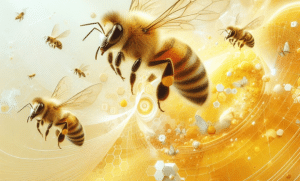
Behavioral Characteristics of Honey Bees
Honey bee, renowned for their fascinating social behavior, exhibit a range of characteristics that contribute to their successful functioning as a colony. These behavioral traits include intricate communication patterns, coordinated foraging activities, and a well-defined social structure.
Honey bees function within a highly organized social structure, with each member playing a specific role. The colony is structured around the queen bee, who is responsible for reproduction, laying eggs, and maintaining the overall unity of the colony. The worker bees, predominantly female, take on the tasks of building and maintaining the hive, collecting nectar and pollen, and caring for the brood. Drones, the male bees, have the sole purpose of mating with a queen from another colony.
Communication among honey bees is achieved through a combination of pheromones, body movements, and buzzing sounds. They use intricate dance patterns, known as the waggle dance, to transmit information about the location of food sources to their fellow foragers. Through these dances, bees convey crucial information about the distance, direction, and quality of the food they have discovered.
For honey bees, foraging is a vital activity that ensures the survival of the colony. Worker bees embark on foraging expeditions in search of nectar and pollen, visiting numerous flowers in the process. They exhibit remarkable navigational skills, using landmarks, the position of the sun, and their internal sense of time to navigate back to the hive and communicate food locations to their nest mates.
Overall, honey bees exhibit complex and highly coordinated behaviors that contribute to the efficient functioning and survival of the colony. Their remarkable communication, foraging, and social traits are instrumental in their exceptional role as pollinators and honey producers.
Social Structure of Honey Bee Colonies
Honey bee colonies exhibit a highly organized social structure that is crucial to their survival and success. At the heart of this structure is the queen bee, who serves as the reproductive powerhouse of the colony. She is responsible for laying eggs, ensuring the production of new generations of bees, and maintaining the unity of the hive.
Surrounding the queen bee are the worker bees, which make up the majority of the colony. These female bees take on a multitude of tasks to support the functioning of the colony. Worker bees are responsible for building and maintaining the hive, collecting nectar and pollen for food, and caring for the brood, which consists of eggs, larvae, and pupae. They also play a crucial role in defending the hive from intruders.
The male bees, known as drones, have a relatively passive role within the social structure. Their primary purpose is to mate with queens from other colonies, contributing to the genetic diversity of the honey bee population. Drones do not have stingers and are unable to forage or defend the hive.
Within the honey bee colony, there is a clear division of labor and hierarchy. Each bee has a specific role and tasks to fulfill, and they work together to ensure the survival and well-being of the entire colony. The social structure of honey bees is a testament to their remarkable coordination and cooperation, enabling them to thrive as a highly organized and efficient society.
Foraging and Communication Patterns of Honey Bees
Honey bees are highly efficient foragers and have sophisticated communication patterns that allow them to gather nectar, pollen, and water for their colony. Foraging behavior is essential for the survival and productivity of honey bee colonies, as it ensures the availability of food resources.
When honey bees search for food, they employ a waggle dance to communicate the location of a productive foraging site to their nestmates. This intricate dance involves the bee moving in a figure-eight pattern while vibrating its abdomen and producing buzzing sounds. Through this dance, the forager conveys information about the distance and direction of the food source, as well as its quality. Other worker bees observe and interpret the dance, enabling them to navigate and locate the foraging site accurately.
In addition to the waggle dance, honey bees also use pheromones to communicate within the colony. Pheromones are chemical signals secreted by bees that transmit specific messages to other members of the hive. For example, the queen bee releases a pheromone known as the queen substance, which maintains harmony within the colony and inhibits the development of other queens.
Furthermore, honey bees communicate through a series of vibrational signals, such as piping and buzzing. These signals are used to coordinate activities within the colony, including swarming and requeening. This communication network ensures efficient division of labor and helps maintain the overall functioning of the hive.
Overall, the foraging and communication patterns of honey bees are vital for their survival and successful functioning as a social insect. Their sophisticated methods of communication ensure effective resource gathering and coordination within the colony.
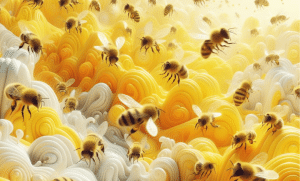
Nesting Habits of Honey Bees
The nesting habits of honey bees play a crucial role in their survival and productivity. Honey bees are known for their intricate and organized nest structures, known as hives. These hives are constructed by worker bees using beeswax, which they produce through special glands on their abdomen.
The formation and construction of honey bee hives are highly organized processes. The queen bee selects a suitable location for the hive, typically in a protected area such as a tree cavity or human-made structures like bee boxes. Worker bees then work together to build the honeycomb cells within the hive. These cells serve as storage units for food, brood, and pollen.
The organization of the nesting environment is also essential for honey bee colonies. The cells within the hive are arranged in a precise hexagonal pattern, maximizing the use of space and ensuring efficient storage. The temperature and humidity levels within the hive are carefully regulated by the bees, creating an optimal environment for the brood to develop.
Honey bees are highly resourceful when it comes to building their nests. They can adapt to various nesting environments, including natural locations and artificial structures provided by beekeepers. The ability to construct and maintain their hives is a testament to the well-developed social structure and behavior of honey bees.
Overall, the nesting habits of honey bees reflect their remarkable organizational skills and adaptation to their surroundings. The construction and organization of their hives contribute to the successful functioning and survival of honey bee colonies.
Formation and Construction of Honey Bee Hives
Honey bee hives are formed and constructed through a collaborative effort by the worker bees in the colony. The process begins with the selection of a suitable location for the hive, often in protected areas like tree cavities or bee boxes provided by beekeepers. The bees then begin constructing the hive using beeswax, which is produced by special glands on their abdomen.
The construction of the hive involves the creation of honeycomb cells. These cells are built in a precise hexagonal pattern, maximizing the use of space and ensuring efficient storage. The bees use the beeswax to construct each cell, carefully shaping them and attaching them to each other to form a comb structure.
The honeycomb cells serve multiple purposes within the hive. They serve as storage units for honey, which is the primary food source for the colony. The cells also serve as chambers for brood development, providing a protected environment for the development of eggs and larvae. Additionally, honeycomb cells are used to store pollen, a vital source of nutrition for the bees.
The construction of the hive and organization of the honeycomb cells also contribute to the thermoregulation of the colony. The bees can control the temperature and humidity levels within the hive, creating an optimal environment for the brood to develop.
Overall, the formation and construction of honey bee hives highlight the remarkable organizational skills and adaptability of honey bees. It showcases their ability to create intricate and efficient structures that support the survival and productivity of the entire colony.
Organization of the Nesting Environment for Honey Bees
The organization of the nesting environment for honey bees is a crucial aspect of their survival and well-being. Honey bees are meticulous in creating and maintaining their hives, ensuring that the nest provides a suitable habitat for the colony.
One essential aspect of the nesting environment is the construction of honeycomb cells. These cells are carefully arranged in a hexagonal pattern, maximizing space efficiency and allowing for the storage of honey, pollen, and brood. The bees use their specialized wax-producing glands to construct the cells, reinforcing them with other substances for structural integrity.
The organization within the hive is highly structured, with specific areas designated for different purposes. The central part of the hive is dedicated to brood rearing, where the queen lays her eggs and the larvae develop. This area is kept at an optimal temperature and humidity to facilitate the growth of the brood.
Surrounding the brood area is the storage section, where honey and pollen are stored. Bees meticulously fill cells with nectar, which is then evaporated and ripened into honey. Pollen, an essential source of protein, is also stored in specific cells.
The outermost layer of the hive contains the honeycomb for storage and acts as insulation for the brood and food stores. This organization helps maintain temperature regulation within the hive, ensuring the comfort and survival of the colony.
In summary, the organization of the nesting environment for honey bees involves the construction of honeycomb cells and the strategic allocation of space for brood rearing, food storage, and insulation. This well-structured and efficient system is vital for the colony’s survival and productivity.
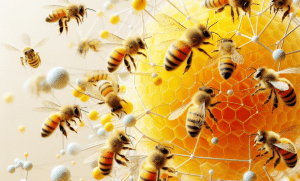
Reproductive Characteristics of Honey Bees
The reproductive characteristics of honey bees play a crucial role in the survival and propagation of the species. Honey bees have a complex reproductive system that involves different castes within the colony: the queen, drones, and worker bees.
The queen is the most critical individual in the colony’s reproduction. She is responsible for laying all the eggs, which can number in the thousands each day. The queen mates with several drones during a mating flight early in her life, storing their sperm for future use. The queen’s ability to control the fertilization of her eggs enables her to lay either fertilized eggs, which develop into female worker bees, or unfertilized eggs, which develop into male drones.
Drones, on the other hand, have one primary purpose: to mate with virgin queens from other colonies. They do not have stingers or the ability to gather food, and their lifespan is limited. Once a drone successfully mates, it subsequently dies.
Worker bees, which are all female, also have some reproductive capabilities, although they typically do not reproduce. Worker bees’ ovaries are underdeveloped, and they have specialized tasks within the colony, such as caring for the brood, collecting nectar and pollen, and constructing the honeycomb.
The reproductive characteristics of honey bees, with the queen playing a central role and the different castes serving specific functions, ensure the colony’s continued survival and genetic diversity. Understanding these characteristics is essential in studying honey bee behavior and developing conservation measures to protect their population.
Life Cycle of a Honey Bee
The life cycle of a honey bee undergoes a fascinating and complex process. It begins with the egg stage, where the queen bee lays an egg in each cell of the honeycomb. The eggs hatch into larvae after a few days. The larvae then go through several stages of development, being fed by worker bees with royal jelly during the first few days and then transitioning to a diet of honey and pollen.
After about a week, the larvae enter the pupa stage, where they undergo metamorphosis and transform into adult bees. The pupa is enclosed in a wax cell, and during this stage, the bee’s body undergoes significant changes. This transformation can take anywhere from 12 to 24 days, depending on the type of bee.
Finally, the adult bee emerges from the cell. At this point, the bee is fully developed and ready to fulfill its role within the colony. Worker bees take on various tasks, including foraging for food, building and maintaining the hive, and caring for the brood. Drones, or male bees, solely focus on mating with virgin queens from other colonies. The queen bee, as the reproductive focal point, is responsible for laying eggs and ensuring the survival of the colony.
Understanding the life cycle of a honey bee is crucial for researchers, beekeepers, and conservationists alike. It allows for the observation and management of colonies, ensuring the well-being and productivity of these vital pollinators.
Role of Queen, Drones, and Worker Bees in Reproduction
The reproductive process in a honey bee colony involves the distinct roles of each bee, including the queen, drones, and worker bees. The queen bee, as the reproductive focal point, plays a vital role in ensuring the survival and growth of the colony. Her primary responsibility is to lay eggs, and she can lay up to 2,000 eggs per day. These eggs are then cared for and nurtured by the worker bees to ensure their development into adult bees.
Drones, on the other hand, are the male bees whose sole purpose is to mate with virgin queens from other colonies. They do not have a stinger and do not gather pollen or nectar. Drones exist solely for reproduction, and their reproductive organs are activated during their flight. They mate with the queen in the air, and after mating, they die.
Worker bees, which are female bees, also contribute to the reproductive process of the colony. While they are unable to mate and lay fertilized eggs like the queen, they assist in raising the brood. They take care of the eggs, larvae, and pupae, feeding them with royal jelly and other nourishing substances to ensure their proper development. Worker bees also engage in other tasks, such as foraging for food, tending to the queen, and building and maintaining the hive.
Overall, the complex reproductive system of honey bees relies on the collaboration and specialization of each bee within the colony. The queen, drones, and worker bees all have essential roles to ensure the continuity and growth of the bee population.
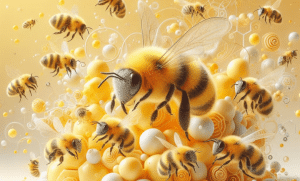
Importance of Honey Bees
Honey bees play a vital role in ecosystems and are crucial for the survival of many plant species. Their primary contribution lies in the pollination process. As honey bees gather nectar from flowers, pollen grains stick to their bodies, and when they move between flowers, these grains are transferred, resulting in cross-pollination. This process enables the production of fruits, vegetables, and seeds. In fact, honey bees are responsible for pollinating approximately one-third of the world’s food crops.
The production of honey is another significant benefit of honey bees. These remarkable insects collect nectar, transform it into honey within their bodies, and store it in their hives. Honey has nutritional value and is a natural sweetener that is widely enjoyed by humans. Additionally, beeswax obtained from honey bee hives is used in various industries, including cosmetics, candles, and pharmaceuticals.
Honey bees also contribute to biodiversity by providing habitat and food for other organisms. Their diverse foraging patterns and busy activities support the health and diversity of plant and animal populations. Furthermore, honey bee colonies serve as indicators of environmental health. They are sensitive to environmental changes, such as pollution and habitat loss, making them crucial indicators for assessing the overall well-being of ecosystems.
Given their immense importance, the decline in honey bee populations due to various factors, including habitat loss, pesticide use, and climate change, is a matter of concern. Conservation efforts are essential to protect and preserve honey bees, including the creation of bee-friendly habitats, reducing pesticide use, and promoting sustainable farming practices. By safeguarding honey bees, we not only ensure the health of ecosystems but also secure our own food supply and well-being.
Pollination Process by Honey Bees
The pollination process carried out by honey bees is a vital ecological service that supports the reproduction of many plant species. As honey bees forage for nectar, pollen grains from the flowers stick to their bodies. When they move between flowers, these grains are transferred, facilitating cross-pollination. This process is essential for the production of fruits, vegetables, and seeds.
The efficiency of honey bees in pollination is remarkable. They have specialized body structures, such as hairy legs and bodies, which help them efficiently collect and transfer pollen. Additionally, honey bees exhibit flower fidelity, meaning they tend to visit specific types of flowers consistently, increasing the chances of successful pollination.
The pollination partnership between honey bees and plants is mutually beneficial. While honey bees gather nectar, they inadvertently transfer pollen, enabling the plants to reproduce. In return, the plants provide the bees with a food source. This symbiotic relationship has evolved over millions of years and demonstrates the interconnectedness of organisms in ecosystems.
The impact of honey bee pollination is significant. Approximately one-third of the world’s food crops rely on honey bee pollination, including important staples like apples, almonds, and berries. Without honey bees, the availability and diversity of these essential foods would be severely compromised.
This highlights the crucial role honey bees play in maintaining biodiversity and sustaining our food supply. Recognizing the value of honey bees and taking measures to protect and support their populations is crucial for ensuring the health and resilience of ecosystems and agriculture.
Production of Honey and other Bee Products
Honey bees are well-known for their production of honey, one of the most popular and widely consumed natural sweeteners. Honey production is a fascinating process carried out by the diligent worker bees within the hive. These bees collect nectar from flowers using their long tongues and store it in their crop, a honey stomach, for transport back to the hive. Once at the hive, the worker bees regurgitate the nectar and pass it along to other workers. Through a process of enzymatic transformation and evaporation, the nectar gradually turns into honey, which is then stored in cells within the hive.
Honey production not only provides a delicious food source for humans but also serves as a vital energy reserve for the honey bees themselves. Bees consume honey during the cold winter months when food sources are scarce.
In addition to honey, honey bees produce other valuable bee products. Beeswax, another secretion of the worker bees, is used to construct the honeycomb cells and seal the hive. It is also used in various industries such as cosmetics, candles, and polishes.
Propolis, a resinous substance collected from tree buds and sap flows, is used by bees to seal and reinforce the hive. Propolis has antimicrobial properties and is often used in alternative medicine.
Royal jelly, a special secretion produced by worker bees, is fed exclusively to the queen bee larvae. It is nutrient-rich and crucial for the development and maintenance of the queen bee.
Overall, the production of honey and other bee products by honey bees not only supports their own survival but also provides valuable resources for humans and various industries. Appreciating and supporting honey bee populations is therefore essential for maintaining the production of these valuable bee products.
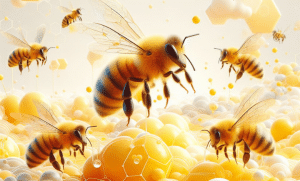
Threats and Conservation Efforts for Honey Bees
Honey bees are facing numerous threats that are impacting their populations worldwide. One major threat is the use of pesticides, particularly neonicotinoids, which can be toxic to bees and have been linked to bee colony collapse disorder. Habitat loss and fragmentation also pose a significant threat as agricultural expansion and urban development reduce the availability of flowering plants that bees rely on for food. Climate change is another concern, as it alters the timing of flowering and can disrupt the synchronized relationship between bees and their food sources. Diseases and parasites, such as the varroa mite, also weaken honey bee colonies and make them more vulnerable to other stressors.
To help protect honey bees, conservation efforts are being implemented at various levels. At the policy level, some countries have banned or restricted the use of certain pesticides harmful to bees. Efforts are also being made to promote sustainable agriculture practices that minimize pesticide use and provide ample forage for bees. The establishment of protected areas and the creation of bee-friendly habitats in urban and rural areas are also crucial for providing safe havens and food sources for honey bees.
Education and awareness campaigns are being conducted to highlight the importance of honey bees in pollination and the need for their conservation. Involving communities and individuals in beekeeping and honey bee conservation initiatives can also contribute to their protection. Research into honey bee health and the development of strategies to combat diseases and parasites are further enhancing conservation efforts. By addressing these threats and implementing effective conservation measures, we can protect honey bees and ensure the continued pollination of our crops and the production of honey for generations to come.
Challenges Faced by Honey Bee Populations
Honey bee populations around the world are facing several challenges that are threatening their survival. One of the biggest challenges is the widespread use of pesticides, particularly neonicotinoids, which can be harmful to bees. These pesticides can impair the bees’ foraging abilities, navigation skills, and immune systems, making them more susceptible to diseases and parasites. The loss and fragmentation of habitat also pose a significant threat to honey bees. As agricultural and urban development continues to expand, the availability of flowering plants, which are crucial for the bees’ food source, is decreasing. This reduced access to nectar and pollen can lead to malnutrition and weaken the overall health of honey bee colonies. Climate change is another major challenge for honey bee populations. Rising temperatures and unpredictable weather patterns can disrupt the synchronization between bees and the blooming of flowers, making it harder for them to find food. Additionally, changes in temperature and humidity can increase the prevalence of diseases and parasites. Finally, diseases and parasites themselves, such as the varroa mite, can have devastating impacts on honey bee colonies. These parasites weaken the bees, making them more susceptible to other stressors and can ultimately lead to colony collapse. The combination of these challenges puts honey bees at great risk, threatening their populations and the critical role they play in pollination.
Conservation Measures to Protect Honey Bees
Conservation efforts are crucial to protect honey bee populations and ensure their survival. Here are some key measures that can be taken to safeguard honey bees:
- Limiting pesticide use: Restricting the use of harmful pesticides, especially neonicotinoids, can significantly reduce the negative impact on honey bees. Implementing integrated pest management practices and promoting the use of organic alternatives can help protect bees and their habitats.
- Enhancing habitat diversity: Creating and preserving diverse habitats rich in flowering plants is essential for honey bees. Planting a variety of native flowers, especially those that provide nectar and pollen throughout the year, can ensure a steady food source for the bees.
- Conserving natural habitats: Protecting natural areas such as meadows, forests, and wetlands is vital for honey bees and other pollinators. These areas offer a diverse range of plant species and provide nesting sites for bees.
- Educating and raising awareness: Increasing public awareness about the importance of honey bees and the threats they face is crucial for their conservation. Educating communities about the role of bees in pollination and promoting bee-friendly practices such as avoiding the use of pesticides in home gardens can make a significant difference.
- Supporting beekeepers: Providing resources and support to local beekeepers is essential for maintaining healthy honey bee populations. This includes promoting best management practices, offering training and education, and assisting with hive maintenance and disease management.
By implementing these conservation measures, we can help protect honey bees and ensure their crucial role in pollination and ecosystem health. It is vital to take action now to secure a sustainable future for these busy pollinators.
As we buzz towards the conclusion of our in-depth look at the fascinating world of honey bee, we invite you to reflect on the incredible characteristics these tiny architects of nature possess. From their complex hive structures to their essential role in pollination, honey bee are more than just producers of sweet honey—they’re crucial players in our ecosystem. We hope this exploration into the lives and traits of the industrious honeybee has been as enlightening for you as it has been for us. Keep an eye out for the next time you encounter these diligent pollinators in the wild, and remember, there’s much more to these creatures than meets the eye. Share your thoughts and any newfound appreciations for honey bee in the comments below. We’d love to hear from you!



